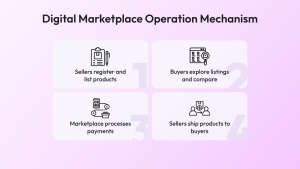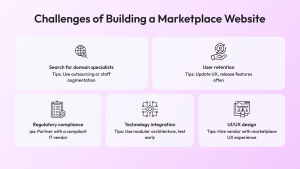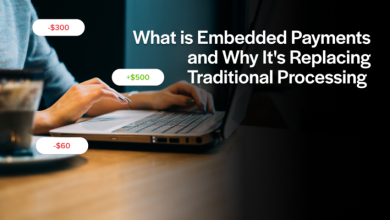
The world of digital marketplaces is always changing, but spinning faster now. It’s no small undertaking to start any kind of marketplace site in 2026, and yet more feasible than ever with platform heavyweights like Amazon, Etsy and Upwork setting the bar. Whether that platform is a B2B “niche” exchange, or a peer-to-peer rental listing site, up to an eCommerce giant, the steps are quite often very similar.
So in this post, we will break down the modern check list of how to build a marketplace website from the ground up: organization, tech stack, features selection, development approaches and roadmap for scaling the marketplace wisely.
What Is a Marketplace Website?
A marketplace is a website that connects buyers and sellers, providing a platform or interface for publishing and browsing listings of products or services, and facilitating a purchase between buyer and seller.
Think Airbnb. It doesn’t own any apartments, but it provides the infrastructure for hosts to list properties and guests to rent them. That’s the marketplace model.
Marketplace platforms can be:
- B2C: Business to consumer (Amazon)
- B2B: Selling business to other businesses (Alibaba)
- P2P: Person to Person trading (eBay)
Few buyers would appreciate having to pay for shipping themselves, either — which brings us to why marketplaces in 2026 have moved beyond physical products. You could build platforms for digital assets, freelance services, gear hire, or niche communities like NFT art trading.
Step 1: Marketplace Niche & Business Model
Focus on your niche before you develop it. If you have the chance to win against some giant, the more niche your target market is, the more likely you are to win.
For example, consider StockX, a sneaker and streetwear marketplace. It made a place for itself with authentication and bidding features. Or Turo, which created a marketplace around car-sharing with insurance baked-in.
Questions to ask:
- Describe your buyers / sellers?
- What is it that you are solving for them?
- Will you take a cut, charge subscriptions or offer freemium access?
Popular revenue models include:
- Percent of each sale ( Etsy)
- Purchase type: Subscription (monthly/annual plans (LinkedIn Premium)
- Posting fees: The cost of posting an ad (Craigslist Pro)
- Freemium: Free plan with advanced paid options (Gumroad)
Step 2: Identify Must-Have Features
A marketplace is an ecosystem that requires supporting both sides of the market — supply and demand.
Core features for sellers:
- Profile creation
- Product/service listing
- Inventory management
- Order tracking
- Messaging with buyers
- Payment withdrawals
Core features for buyers:
- Registration/login
- Product/service search and filters
- Reviews and ratings
- Chat or messaging
- Secure checkout
- Order history
Admin panel features:
- User management
- Listing moderation
- Analytics dashboard
- Commission settings
- Dispute resolution tools
Step 3: Choosing the Right Technology Stack
Your tech stack will depend on your available budget, timeline and scalability requirements.
Leverage out-of-the-box marketplace platforms or no-code tools
If you’re looking to set off just an MVP or a side project, there are easy tools to get started like Sharetribe, Arcadier or multi-vendor plugins for Shopify where code is less per cent of your work.
Customized marketplace development
If you are planning to scale, own your infrastructure, or need to build unique workflows, you will want custom development. This approach also gives you full control over the cost to build a marketplace app, allowing you to align functionality and budget with your business goals.
Popular 2026 tech stacks:
- Frontend: React, Vue, Next.js
- Backend: Node. js, Ruby on Rails, Django
- Database: PostgreSQL, MongoDB
- Payments: Stripe, PayPal, Adyen
- Cloud hosting: AWS, Google, Vercel
Step 4: Trust and Convert Design
Well, there is a lot more to it, trust sits at the foundation of an efficient marketplace. Security has to be mutual — both sides of the interaction are users.
Some of the UX/UI elements which you can implement to earn trust:
- Badges for verified user profiles and sellers
- Clear review and rating systems
- Secure payment gateway integrations
- Transparent policies (refunds, cancellations)
- Escrow or basic hold payment until delivery
Focus on conversion-driven design, which translates to instant sign-ups, fast page loads, one-click actions, and mobile-optimized journeys. Example from the real world is the following: Airbnb boosted conversion rates by a hefty margin after knocking out a single step of their booking flow.
Step 5: Build Your MVP, Test It and Release It
Do not develop every component of the software together. Start lean. The MVP should provide the value proposition of your MVP for your first users.
Break development into phases:
- Phase 1. Build the core flows — signup, listing, search, booking and payment
- Phase 2. Start private beta. Gather real feedback
- Phase 3. Add messaging, notifications, analytics
- Phase 4. Be ready for heavy user loads, add features, optimize
Check on different devices and browsers. Simulate environments with tools like BrowserStack or LambdaTest.
Step 6: Drive the Supply/Demand
A marketplace is no better than the people who use it. You will require a strong GTM for both sides of the platform.
To attract sellers:
- Provide early-bird benefits or lower commission
- Provide onboarding help (videos, tutorials)
- Showcase initial traffic and demand
To attract buyers, work on:
- SEO-optimized product pages
- Google, Instagram or TikTok targeted Ads
- Influencer or affiliate marketing
- Launch discounts or referral programs
Start local or niche. Specialized marketplaces tend to develop quicker compared to those attempting to cater to all.

How Much Would It Cost to Build a Marketplace Website
- No-code/low-code MVP: $1,000–$10,000
- Agency/Devs Custom-built MVP: $25, 000–$70, 000
- Full-scale custom platform: $100,000+
The variable nature of factors like feature set, complexity, custom integrations, and design. For initial projects use some open-source tools such as Sharetribe Flex or get in touch with a startup-friendly development team to cut the cost.
Final Thoughts
Creating a marketplace website in 2026 will not only be for the tech giants. Even niche players can find a way to succeed with the right technology stack, strategy, and value prop in place.
It is all about keeping the scale, any scale, and staying user obsessive and straight to the point. Work on a real-world problem committed to real-world audience, and enter your marketplace will emerge and flourish.
And to be honest, everywhere else, your liquidity should always trump everything in marketplaces. The users who are doing more, the faster(slower) the flywheel.





